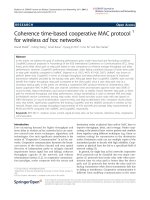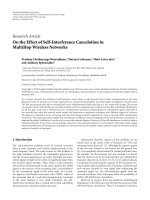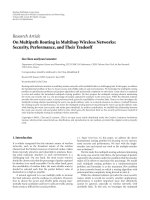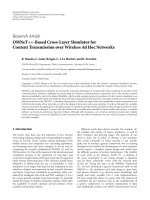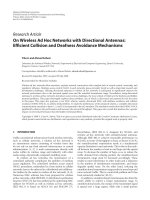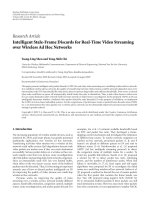Fairness issues in multihop wireless ad hoc networks
Bạn đang xem bản rút gọn của tài liệu. Xem và tải ngay bản đầy đủ của tài liệu tại đây (1.06 MB, 175 trang )
FAIRNESS ISSUES IN MULTIHOP WIRELESS AD
HOC NETWORKS
HE JUN
NATIONAL UNIVERSITY OF SINGAPORE
2005
FAIRNESS ISSUES IN MULTIHOP WIRELESS AD
HOC NETWORKS
HE JUN
(B.Eng. and M.Eng., Zhejiang University)
A THESIS SUBMITTED
FOR THE DEGREE OF DOCTOR OF PHILOSOPHY
DEPARTMENT OF COMPUTER SCIENCE
NATIONAL UNIVERSITY OF SINGAPORE
2005
Acknowledgments
First and foremost, I wish to express my deepest gratitude to my supervisor, Dr.
Pung Hung Keng. His guidance, support and kindness have made this work possible.
Dr. A.L.Ananda, Dr. Lillykutty Jacob and Dr. Chan Mun Choon have served as my
reviewers at different stages of this thesis. I would like to express my appreciation for
their suggestions and comments and their time in reviewing this thesis.
I sincerely thank Ms Leong Alexia who spent a lot of time to thoroughly proofread
the thesis.
I am grateful to the National University of Singapore (NUS) for offering me a research
scholarship and providing nice facilities and services, which make my research smooth
and enjoyable.
I would like to thank all my colleagues in the Network Systems & Services Laboratory
(NSSL) and the Center for Internet Research (CIR), especially Ding Aijun, Zhu Bo, Peng
Bin, Dai Jinquan, Yoong Cheah Huei, Gu Tao, Zhou Lifeng, Feng Yuan, Zhang Caihong,
Chen Xiaodong, Yao Jiankang and An Liming.
Finally, I would like to thank my parents and my sisters for their love, support and
patience during the course of my doctoral studies.
i
Table of Contents
Acknowledgments . . . . . . . . . . . . . . . . . . . . . . . . . . . . . . . . . . i
Table of Contents . . . . . . . . . . . . . . . . . . . . . . . . . . . . . . . . . . ii
List of Tables . . . . . . . . . . . . . . . . . . . . . . . . . . . . . . . . . . . . . vii
List of Figures . . . . . . . . . . . . . . . . . . . . . . . . . . . . . . . . . . . . viii
Abbreviation List . . . . . . . . . . . . . . . . . . . . . . . . . . . . . . . . . . xi
Summary . . . . . . . . . . . . . . . . . . . . . . . . . . . . . . . . . . . . . . . xii
Publications . . . . . . . . . . . . . . . . . . . . . . . . . . . . . . . . . . . . . . xiv
1 Introduction . . . . . . . . . . . . . . . . . . . . . . . . . . . . . . . . . . . 1
1.1 MAC/Link Layer Fairness and Network Layer Fairness . . . . . . . . . . 2
1.1.1 MAC/Link Layer (Hop-to-Hop) Fairness in Wireline Networks . 2
1.1.2 Network Layer (End-to-End) Fairness in Wireline Networks . . . 4
1.2 Fairness Criteria . . . . . . . . . . . . . . . . . . . . . . . . . . . . . . . 6
1.2.1 Max-min Fairness . . . . . . . . . . . . . . . . . . . . . . . . . . 6
1.2.2 Proportional Fairness . . . . . . . . . . . . . . . . . . . . . . . . 6
1.2.3 Potential Delay Minimization Fairness . . . . . . . . . . . . . . . 7
1.2.4 General Fairness Model . . . . . . . . . . . . . . . . . . . . . . . 7
ii
1.2.5 Fairness Models and Fairness Algorithms . . . . . . . . . . . . . 8
1.3 Characteristics of Multihop Wireless Channel . . . . . . . . . . . . . . . 8
1.3.1 Model of Multihop Wireless Ad Hoc Networks . . . . . . . . . . 10
1.4 Fairness Issues in Multihop Wireless Ad Hoc Networks . . . . . . . . . . 12
1.4.1 MAC/Link Layer (Hop-to-Hop) Fairness in MANETs . . . . . . 12
1.4.1.1 Difficulties of Applying Fair Queueing-Scheduling over a
Wireless Channel . . . . . . . . . . . . . . . . . . . . . 13
1.4.2 Network Layer (End-to-End) Fairness in MANETs . . . . . . . . 16
1.5 Contributions and Structure of Thesis . . . . . . . . . . . . . . . . . . . 17
2 MAC Layer Fairness Problem Demonstration and Analysis . . . . . 21
2.1 Lack of Synchronization Problem (LSP) and Lack of Coordination Prob-
lem (LCP) . . . . . . . . . . . . . . . . . . . . . . . . . . . . . . . . . . . 24
2.2 Double Contention Areas Problem . . . . . . . . . . . . . . . . . . . . . 28
2.3 Further Analysis of the One/Zero Fairness Problem . . . . . . . . . . . . 29
2.4 Summary . . . . . . . . . . . . . . . . . . . . . . . . . . . . . . . . . . . 33
3 Fairness of Medium Access Control Protocols for Multihop Wireless
Ad Ho c Networks . . . . . . . . . . . . . . . . . . . . . . . . . . . . . . . . . . 34
3.1 Fairness Problems in Multihop Wireless Networks and Related Work . . 36
3.2 Extended Hybrid Asynchronous Time Division Multiple Access Protocol
(EHATDMA) . . . . . . . . . . . . . . . . . . . . . . . . . . . . . . . . . 43
3.2.1 SI-RI Hybrid Scheme . . . . . . . . . . . . . . . . . . . . . . . . . 43
3.2.2 ATDMA — Asynchronous Time Division Multiple Access . . . . 47
iii
3.2.3 Power Control . . . . . . . . . . . . . . . . . . . . . . . . . . . . 51
3.3 Performance Evaluation and Comparison . . . . . . . . . . . . . . . . . 53
3.3.1 Performance Metrics . . . . . . . . . . . . . . . . . . . . . . . . . 55
3.3.2 Simulation Scenarios . . . . . . . . . . . . . . . . . . . . . . . . . 58
3.3.2.1 Wireless LAN Scenarios . . . . . . . . . . . . . . . . . . 58
3.3.2.2 Typical Scenarios . . . . . . . . . . . . . . . . . . . . . 59
3.3.2.3 General Scenarios . . . . . . . . . . . . . . . . . . . . . 60
3.3.3 Simulation Results . . . . . . . . . . . . . . . . . . . . . . . . . . 60
3.3.3.1 Simulation Results of WLAN Scenarios . . . . . . . . . 61
3.3.3.2 Simulation Results of Typical Scenarios . . . . . . . . . 64
3.3.3.3 Simulation Results of General Scenarios . . . . . . . . . 68
3.3.4 The Impact of the Ratio of the Carrier Sensing Range to the
Communication Range . . . . . . . . . . . . . . . . . . . . . . . . 69
3.3.5 The Impact of Mobility and the Convergence Time of EHATDMA 71
3.4 Overhead and Implementation Complexity of EHATDMA . . . . . . . . 73
3.5 The Analysis of Individual Mechanisms . . . . . . . . . . . . . . . . . . 74
3.5.1 The Effects of Single/Multiple Scheduling Strategy and Out-of-
order Backoff . . . . . . . . . . . . . . . . . . . . . . . . . . . . . 74
3.5.2 The Effects of Hybrid, ATDMA and Power Control . . . . . . . . 75
3.6 Summary . . . . . . . . . . . . . . . . . . . . . . . . . . . . . . . . . . . 78
4 Fairness and Throughput Analysis of IEEE 802.11 in Multihop Wire-
less Ad Hoc Networks . . . . . . . . . . . . . . . . . . . . . . . . . . . . . . . 81
iv
4.1 Distributed Coordination Function of IEEE 802.11 . . . . . . . . . . . . 84
4.1.1 The Basic Access Method . . . . . . . . . . . . . . . . . . . . . . 84
4.1.2 The RTS/CTS Access Method . . . . . . . . . . . . . . . . . . . 85
4.2 Analytical Model of DCF in Multihop Wireless Networks . . . . . . . . 86
4.2.1 Assumptions, Throughput and Fairness Definitions . . . . . . . . 86
4.3 Three-Dimensional Markov Chain . . . . . . . . . . . . . . . . . . . . . . 90
4.4 Throughputs of the Basic Access Method . . . . . . . . . . . . . . . . . 97
4.4.1 Transmission Probability τ and Idle Probability Π
I
. . . . . . . . 97
4.4.2 Transmission Collision Probability p(r) . . . . . . . . . . . . . . 98
4.4.3 Throughputs of the Basic Access Method . . . . . . . . . . . . . 102
4.4.4 Model Validation for the Basic Access Method . . . . . . . . . . 103
4.5 Throughputs of the RTS/CTS Access Method . . . . . . . . . . . . . . . 105
4.5.1 Transmission Probability τ and Idle Probability Π
I
. . . . . . . . 105
4.5.2 RTS Frame Collision Probability p
rts
(r) and Data Frame Collision
Probability p
data
(r) . . . . . . . . . . . . . . . . . . . . . . . . . . 106
4.5.3 Throughputs of the RTS/CTS Access Method . . . . . . . . . . 109
4.5.4 Model Validation for the RTS/CTS Access Method . . . . . . . . 110
4.6 Throughput Performance Evaluation . . . . . . . . . . . . . . . . . . . . 111
4.6.1 Channel Saturation Throughput . . . . . . . . . . . . . . . . . . 111
4.6.2 Maximum Channel Saturation Throughput . . . . . . . . . . . . 114
4.7 Fairness Evaluation . . . . . . . . . . . . . . . . . . . . . . . . . . . . . . 116
4.7.1 Fairness of Long-run Flow Throughput . . . . . . . . . . . . . . . 116
4.7.2 Fairness of Instant Flow Throughput . . . . . . . . . . . . . . . . 119
v
4.7.3 Non-work-conserving Principles . . . . . . . . . . . . . . . . . . . 121
4.8 Summary . . . . . . . . . . . . . . . . . . . . . . . . . . . . . . . . . . . 125
5 Evaluation and Comparison of TCP Performance over Four MAC Pro-
tocols for Multihop Wireless Ad Hoc Networks . . . . . . . . . . . . . . . 128
5.1 TCP Performance Problems in Multihop Wireless Ad Hoc Networks . . 129
5.2 TCP Performance Evaluation and Comparison . . . . . . . . . . . . . . 132
5.2.1 Instability Problem . . . . . . . . . . . . . . . . . . . . . . . . . 134
5.2.2 Serious Unfairness Problem . . . . . . . . . . . . . . . . . . . . . 138
5.2.3 Incompatibility Problem . . . . . . . . . . . . . . . . . . . . . . 140
5.3 Summary . . . . . . . . . . . . . . . . . . . . . . . . . . . . . . . . . . . 142
6 Conclusion and Future Research . . . . . . . . . . . . . . . . . . . . . . . 144
6.1 Summary . . . . . . . . . . . . . . . . . . . . . . . . . . . . . . . . . . . 144
6.2 Directions for Future Work . . . . . . . . . . . . . . . . . . . . . . . . . 148
Bibliography . . . . . . . . . . . . . . . . . . . . . . . . . . . . . . . . . . . . . 152
vi
List of Tables
2.1 NS-2 simulation parameters for one/zero fairness problem . . . . . . . . 24
2.2 Scenarios used to show LSP and LCP . . . . . . . . . . . . . . . . . . . 26
2.3 Simulation results for scenario (A) and (B) with IEEE 802.11 . . . . . . 26
2.4 Scenarios used to show DCP . . . . . . . . . . . . . . . . . . . . . . . . 28
2.5 Simulation results for scenario (C) and (D) with IEEE 802.11 . . . . . . 29
3.1 NS-2 Simulation Parameters . . . . . . . . . . . . . . . . . . . . . . . . . 55
5.1 NS-2 simulation parameters for TCP performance evaluation . . . . . . 133
vii
List of Figures
1.1 MAC/Link layer fairness and network layer fairness in wireline networks 3
1.2 Hidden terminal, exposed terminal and capture . . . . . . . . . . . . . . 9
1.3 Model of a Multihop Wireless Ad Hoc Network . . . . . . . . . . . . . . 11
1.4 MAC/Link layer fairness in cellular network/wireless LAN, single-hop
wireless ad hoc network and multihop wireless ad hoc network . . . . . 14
2.1 LCP vulnerability analysis . . . . . . . . . . . . . . . . . . . . . . . . . . 32
2.2 Vulnerable probability versus capture threshold . . . . . . . . . . . . . . 32
3.1 A carrier sense wireless network with three types of link . . . . . . . . . 37
3.2 Format of control frames . . . . . . . . . . . . . . . . . . . . . . . . . . . 44
3.3 Selection of operating mode for a flow . . . . . . . . . . . . . . . . . . . 45
3.4 Typical scenarios . . . . . . . . . . . . . . . . . . . . . . . . . . . . . . . 59
3.5 General scenarios . . . . . . . . . . . . . . . . . . . . . . . . . . . . . . . 61
3.6 Simulation results of WLAN scenarios . . . . . . . . . . . . . . . . . . . 62
3.7 Simulation results of typical scenarios . . . . . . . . . . . . . . . . . . . 65
3.8 Fundamental conflict between fairness and throughput . . . . . . . . . . 66
3.9 Simulation results of general scenarios . . . . . . . . . . . . . . . . . . . 68
3.10 The effects of carrier sensing range . . . . . . . . . . . . . . . . . . . . . 70
3.11 An example of the F I
m
(t) of EHATDMA in general scenario 8 . . . . . 72
viii
3.12 The effects of the hybrid scheme, the ATDMA scheme and the power-
control scheme . . . . . . . . . . . . . . . . . . . . . . . . . . . . . . . . 76
4.1 The basic access method in DCF . . . . . . . . . . . . . . . . . . . . . . 84
4.2 The RTS/CTS access method in DCF . . . . . . . . . . . . . . . . . . . 86
4.3 Overall Markov chain model for a node . . . . . . . . . . . . . . . . . . 92
4.4 M
r
k
: Markov chain model of the binary exponential backoff (BEB) win-
dow scheme for transmissions with a distance r
k
. . . . . . . . . . . . . 93
4.5 Illustration of hidden area for RTS and DATA frames . . . . . . . . . . 99
4.6 Saturation throughput of the basic access metho d: analysis versus simu-
lation . . . . . . . . . . . . . . . . . . . . . . . . . . . . . . . . . . . . . 104
4.7 Illustration of hidden area for CTS frame . . . . . . . . . . . . . . . . . 107
4.8 Saturation throughput of the RTS/CTS access method: analysis versus
simulation . . . . . . . . . . . . . . . . . . . . . . . . . . . . . . . . . . . 110
4.9 Channel saturation throughput (PHY=DSSS) . . . . . . . . . . . . . . 112
4.10 Maximum channel saturation throughput (PHY=DSSS) . . . . . . . . . 114
4.11 Long-run flow throughput fairness: theoretical results . . . . . . . . . . 117
4.12 Long-run flow throughput validation: theoretical and simulation results 118
4.13 Instant flow throughput fairness: theoretical results . . . . . . . . . . . 119
4.14 Instant flow throughput validation: theoretical and simulation results . 120
4.15 Long-run flow throughput versus distance: simulation results for standard
IEEE 802.11 and non-work-conserving IEEE 802.11 . . . . . . . . . . . . 123
ix
4.16 Instant flow throughput versus distance: simulation results for standard
IEEE 802.11 and non-work-conserving IEEE 802.11 . . . . . . . . . . . 125
4.17 Node throughput comparison, standard IEEE 802.11 versus non-work
conserving IEEE 802.11 (PHY=DSSS) . . . . . . . . . . . . . . . . . . 126
5.1 Simulation scenarios . . . . . . . . . . . . . . . . . . . . . . . . . . . . . 131
5.2 Simulation results for instability problem . . . . . . . . . . . . . . . . . 135
5.3 Simulation results for serious unfairness problem . . . . . . . . . . . . . 139
5.4 Simulation results for incompatibility problem . . . . . . . . . . . . . . . 141
x
Abbreviation List
AAT Average Attempts per packet
ACK Acknowledgment
AT Aggregate Throughput
ATDMA Asynchronous Time Division Multiple Access
BEB Binary Exponential Backoff
CBFAIR Connection Based Fair backoff
CE Channel Efficiency
CS Carrier Sense
CTS Clear To Send
DCF Distributed Coordination Function
DCP Double Contention Areas Problem
DWOP Distributed Wireless Ordering Protocol
EDWOP Extended DWOP
EHATDMA Extended Hybrid ATDMA
EMLM Enhanced Maximize-Local-Minimum fair queueing
FI Fairness Index
F I
m
Max-min Fairness Index
HATDMA Hybrid ATDMA
LCP Lack of Coordination Problem
LSP Lack of Synchronization Problem
MANET Multihop wireless Ad Hoc Network
MBFAIR Measurement Based Fair backoff
NAV Network Allocation Vector
RI Receiver Initiated
R
min
Minimum Throughput Rate
RTS Request To Send
SI Sender Initiated
xi
Summary
A multihop mobile wireless ad hoc network (MANET) is a self-organizing and self-
configuring network that can be instantly set up, and it operates without any pre-existing
communication infrastructure except nodes, which themselves may move around in an
arbitrary way. One of the important issues in the design of a MANET is how network
bandwidth is to be shared among competing users. Fairness is one of the important
properties desired in allocating bandwidth. Although much research has been done on
in fairness of bandwidth allocation in the context of wireline networks, the algorithms
developed in wireline networks for fair bandwidth provision cannot be easily extended
to this new context. This is due to the unique characteristics of multihop wireless ad
hoc networks. In this thesis, we investigate the fairness problem in multihop wireless
ad hoc networks. We look into the fairness problem at two levels: the MAC/link layer
and the network layer, with particular emphasis on MAC/link layer fairness, which is
believed to be an important foundation for better network layer fairness.
By simulation, we demonstrate that when applied in multihop wireless ad hoc net-
works, the widely used MAC protocol IEEE 802.11 could suffer from a severe fairness
problem: some link layer flows could seize the whole channel bandwidth (one) while
others get virtually nothing (zero). Three causes leading to the one/zero fairness prob-
lem are identified: the lack of synchronization problem (LSP), the lack of coordination
problem (LCP) and the double contention areas problem (DCP). Based on the analysis,
xii
we propose a new MAC protocol named extended hybrid asynchronous time division
multiple access (EHATDMA), which employs three mechanisms addressing the three
problems mentioned above. Comprehensive simulations show that while various en-
hancements have been proposed to improve the fairness of MAC protocols in multihop
wireless networks, most of them are still strongly biased towards throughput when a
conflict between throughput and fairness arises. On the other hand, EHATDMA strikes
a good balance between throughput and fairness. Our simulation results also reveal that
the most important mechanism for improving fairness of wireless channel sharing is the
non-work-conserving mechanism.
A three-dimensional Markov model is proposed to further analyze the throughput
and fairness properties of IEEE 802.11 in multihop wireless ad hoc networks. Our anal-
ysis reveals that the RTS/CTS access method with the default parameters op erates
almost optimally in terms of saturation throughput. By extrapolating from the analyt-
ical model, we confirm the conclusion that non-work-conserving principles will improve
MAC/link layer fairness.
Since end-to-end traffic in MANETs is expected to be mostly TCP-like, just as in
Internet, we evaluate and compare the performance of TCP over IEEE 802.11 and three
fair MAC protocols. The results show that fair MAC protocols do improve fairness of
bandwidth allocation among TCP flows. In addition, they could also improve other
performance aspects of TCP flows, such as stability and compatibility.
xiii
Publications
[1] Jun He and Hung Keng Pung, “One/Zero Fairness Problem of MAC Protocols
in Multi-hop Ad Hoc Networks and Its Solution,” International Conference on
Wireless Networks (ICWN), Las Vegas, Nevada, USA, 2003, pp. 479-485.
[2] Jun He and Hung Keng Pung, “A Fairer Multiple Access Protocol for Multi-
hop Wireless Networks: Hybrid Asynchronous Time Division Multiple Access
Protocol (HATDMA),” IEEE Conference on Local Computer Networks (LCN),
Bonn/K¨onigswinter, Germany, 2003, pp. 356-365.
[3] Jun He and Hung Keng Pung, “Performance Modeling and Evaluation of IEEE
802.11 Distributed Coordination Function in Multihop Wireless Networks,” IEEE
International Conference on Networks (ICON), Singapore, 2004, pp. 73-79. (Best
Student Paper)
[4] Jun He and Hung Keng Pung, “Fairness of Medium Access Control Protocols for
Multihop Ad Hoc Wireless Network,” accepted by Computer Networks Journal.
xiv
CHAPTER 1
Introduction
A multihop mobile wireless ad hoc network (MANET
1
) is a self-organizing and self-
configuring network that can be instantly set up, and it operates without any pre-
existing communication infrastructure except nodes, which themselves may move around
in an arbitrary way [1]. While these intriguing features (instant setup, infrastructure
independence) enable a MANET to be deployed in many situations where traditional
networks are either unavailable, infeasible or impossible — such as battle fields, disaster
recovery, law enforcement, etc., they also impose huge challenges. Many fundamental
issues need to be further investigated before MANETs can be applied in real life. Such
issues include MAC layer protocols, routing protocols, security, etc. [2–4]. In this thesis,
we are interested in the fairness of bandwidth allocation that a MANET delivers to end-
users. Fairness is used to measure how entities in consideration share a resource. It is
a desirable and important property for best effort service as well as for differentiated
service (DiffServ) [5], in which flows belonging to the same class require bandwidth
allocated to that class to be fairly share. Although much research has been done on
fairness of bandwidth allocation in the context of wireline networks, the algorithms
developed for wireline network fair bandwidth provision cannot be easily extended to
1
In [1], MANET stands for Mobile Ad hoc NETwork. In this thesis, we use the acronym in a slightly
different way. It stands for Multihop wireless Ad hoc NETwork (including both static and mobile
networks) to emphasize the multihop property.
1
MANETs due to the unique characteristics of MANETs. It is hence our objectives in
this thesis to: (i) investigate the factors affecting fairness of bandwidth provision, and
(ii) propose solutions to improve fairness in the context of MANETs.
1.1 MAC/Link Layer Fairness and Network Layer Fairness
Fairness is a measure reflecting how a resource is shared among competing entities. In a
network, the resource in consideration is usually bandwidth. It could be the bandwidth
of a link or the bandwidth of the whole network. Therefore, the fairness problem in a
network can be investigated at two different levels: the media access control (MAC)/link
layer and the network layer. In wireline network research, much has been done on fair
bandwidth provision at both levels.
1.1.1 MAC/Link Layer (Hop-to-Hop) Fairness in Wireline Networks
At the link layer, a flow is defined as a packet stream between neighboring nodes. Several
flows compete with one another to access an output link. In wireline networks, all flows
competing for an output link are maintained in the same node, which has full control
over the output link (Figure 1.1(a)). A scheduler in the node is used to determine the
order of service so as to satisfy certain fairness criteria. The scheduler usually needs to
decide:
(a) which flow is to be served next;
(b) when to put a packet from the next flow into transmission.
Since in wireline networks, all competing flows reside in the same node, the scheduler has
all the information needed to perform task (a). Furthermore, the scheduler is notified
2
. . .
f1
. . .
f2
. . .
. . .
fn
Fixed
Wireline Host
Scheduler
Output
Wireline Link
(a) MAC/Link layer fairness in wireline network: local property — the scheduler
in a host has full control over an output link and it also has precise and complete
information of all flows competing for the output link
a
b
c
d
e
f
f1 f2 f3 f4 f5
f6
f7
(b) Network layer fairness in wireline network: global property — schedulers in dif-
ferent hosts need to cooperate to achieve a desired fairness criterion
Figure 1.1: MAC/Link layer fairness and network layer fairness in wireline networks
immediately by the transmitter at the end of a transmission, which is the exact point in
time to put the next packet into transmission (task (b)). MAC/Link fairness in wireline
networks is therefore a local property, i.e., the scheduler does not need to consult the
schedulers of other nodes to perform these two tasks. We will show later on that the
locality of these two tasks no longer holds in multihop wireless ad hoc networks, which
makes fair bandwidth provision far more difficult in that new context.
The classic fairness criterion in the allocation of link layer bandwidth among multiple
flows is max-min fairness. It reflects the intuitive notion of fairness that any flow should
be entitled to as much channel share as any other flow [6]. The Generalized Processor
Sharing (GPS) policy ([7–9]) is an ideal fair scheduling discipline which exactly realizes
3
the max-min fairness criterion. The GPS scheduler uses a fluid flow model, visiting
backlogged flows in a round-robin fashion and serving each flow an infinitesimal amount
of data that is proportional to the weight associated with the flow. In GPS, if N flows
being served by the server (output link) have positive weights φ(1), φ(2), . . . , φ(N), then
the server (output link) serves S(i, τ, t) amount of data from the i
th
flow in the interval
[τ, t], such that for any flow i backlogged (the queue for this flow is not empty) in [τ, t],
and for any other flow j, we have:
S(i, τ, t)
S(j, τ, t)
≥
φ(i)
φ(j)
(1.1)
GPS ensures that non-backlogged flows get as much service as they requires, while back-
logged flows share the remaining bandwidth in proportion to their weights, i.e., GPS
achieves max-min (weighted) fair bandwidth allocation. GPS is not practical since it
requires formula (1.1) be satisfied in any infinitesimal interval. Many packetized schedul-
ing disciplines have been proposed to approximate GPS, e.g., Weighted Round Robin
(WRR), Deficit Round Robin (DRR), Weighted Fair Queuing (WFQ), Self-Clocked
Fair Queuing (SCFQ), Worst-case Fair Weighted Fair Queuing (W F
2
Q) [10]. All these
queuing disciplines are centralized and require precise information about the contending
flows.
1.1.2 Network Layer (End-to-End) Fairness in Wireline Networks
At the network layer, a flow is defined as a stream of packets which traverse from a
source to a destination along a predefined route (Figure 1.1(b)). The network as a
4
resource is to be shared by all flows in the network. Since the length of the route may
be longer than one hop, fairness at the network layer is no longer a local property, but
a global property: nodes in a network must cooperate to achieve network layer fairness.
Therefore, distributed algorithms are desired.
Network model of wireline networks: A wireline network can be modeled as a set
of interconnected links L where each link l ∈ L has a fixed capacity C
l
. A set of flows
F compete for access to these links. Each flow f in F associates with a route r which
is a subset of L. l ∈ f denotes that flow f goes through link l. f l denotes the set
of flows which goes through l. λ
f
denotes bandwidth allocation for flow f. A feasible
bandwidth allocation scheme must satisfy the capacity constraint:
fl
λ
f
≤ C
l
, l ∈ L. (1.2)
Subject to the capacity constraint (1.2), various fairness criteria have been proposed
in the literature. Among these, three fairness models have been of particular interest to
the research community: max-min fairness, proportional fairness and minimum potential
delay fairness [11]. We introduce these fairness criteria
2
in the next section. It should
be noted that these fairness criteria are also applicable at the MAC/link layer.
2
In this thesis, we use fairness criterion and fairness model interchangeably.
5
1.2 Fairness Criteria
1.2.1 Max-min Fairness
The objective of max-min fairness is to maximize the bandwidth allocated to each flow
f, subject to the capacity constraint (1.2) that an incremental increase in f’s allocation
does not cause decrease in some other flow’s allocation that is already as small as f’s or
smaller [6]. Formally, for every flow f, there is at least one link l ∈ f, such that
f
l
λ
f
= C
l
and
λ
f
φ
f
= max{
λ
f
φ
f
, f
l}, (1.3)
where φ
f
is the weight for flow f. In the above requirements,
f
l
λ
f
= C
l
indicates
link l is a bottleneck link, i.e., it has been fully utilized. And
λ
f
φ
f
= max{
λ
f
φ
f
, f
l}
means that the weighted bandwidth
λ
f
φ
f
allocated to flow f is the largest among all flows
passing through the bottleneck link l. When the number of resources and the number
of flows are both finite, there is only one allocation satisfying max-min fairness.
1.2.2 Proportional Fairness
The objective of proportional fairness is to maximize:
F
φ
f
log λ
f
, (1.4)
subject to the capacity constraint (1.2), where φ
f
is the weight for flow f. Or equiva-
lently, for any other feasible λ
f
, the aggregate of the weighted proportional rate changes
with respect to the optimum allocation λ
f
is negative, i.e.,
F
φ
f
(λ
f
− λ
f
)/λ
f
≤ 0.
6
Again, proportional fairness allocation is unique to networks with finite flows and finite
resources.
1.2.3 Potential Delay Minimization Fairness
The objective of potential delay minimization fairness is to minimize
F
φ
f
/λ
f
, (1.5)
subject to the capacity constraint, where φ
f
is the weight for flow f. This model tries
to minimize aggregate transfer delay since transfer time is approximately proportional
to the reciprocal of bandwidth.
1.2.4 General Fairness Model
Proportional fairness penalizes long routes more severely than max-min fairness in the
interest of greater overall throughput; potential delay minimization fairness lies between
them [11]. It should be noted that besides these three fairness models, other fairness
models are also possible. [12] has shown that there is a general equivalence between
maximizing utility functions and achieving some system-wide notion of fairness. A
utility function U(λ
f
) is a function of bandwidth allocation λ
f
, which is continuous,
differentiable, increasing and strictly concave over the range λ
f
≥ 0. Thus by giving
utility function U(λ
f
), a new fairness model can be defined. In [13], the following class
7
of utility functions is proposed:
U
i
(λ
i
, α) =
(1 − α)
−1
λ
1−α
i
if α = 1
log λ
i
if α = 1
for α ≥ 0. This includes all the previously considered allocation policies — max-min
proportional fairness (α = ∞), proportional fairness (α = 1) and minimum potential
delay (α = 2).
1.2.5 Fairness Models and Fairness Algorithms
We would like to point out that although the fairness criteria introduced in this section
were originally developed for wireline networks, they do not depend on the characteristics
of the underlying network. Therefore, they can be applied in wireless networks as well.
However, the algorithms developed for wireline networks to achieve these fairness models
usually depend on properties of wireline networks which are absent in wireless networks.
For example, scheduling algorithms take advantage of the local property of a wireline
output link as we have shown in Subsection 1.1.1. Hence these algorithms cannot be
applied directly to wireless networks. In the following sections, we will discuss the
characteristics of a multihop wireless channel and the fairness problems in a MANET
in detail.
1.3 Characteristics of Multihop Wireless Channel
The wireless channel of a MANET is very different from a traditional wireline channel.
The bandwidth available on a wireless channel is much narrower than that of a wireline
8
A B C D
(a) Hidden terminal and exposed terminal
A B C
Power difference
of signal A and B
(b) Capture effect
Figure 1.2: Hidden terminal, exposed terminal and capture
channel. In addition, due to the effect of multi-path propagation and interference, the
received signal strength at the receiver varies as a function of time; as a result the capac-
ity of a wireless channel varies as a function of time. Furthermore, the wireless medium
is inherently a shared medium: nodes within the joint neighborhood of the sender and
the receiver of a flow contend for the limited bandwidth; thus the available bandwidth
between a pair of neighbors is even lower and it is not fixed. Finally, the bit error ratio
(BER) of a wireless channel is much higher than that of a wireline channel. Besides
capacity limitation and high BER, another negative property of a wireless channel is
location-dependent carrier sensing [14]. Since the transmission range of a radio signal is
limited, only the nodes within a specific radius of the transmitter can detect the carrier
on the channel. Location-dependent carrier sensing results in following three types of
nodes that are problematic to the designers of multihop wireless networks, especially
MAC protocol designers:
• Hidden Nodes: A hidden node is one that is within the range of the intended
destination but out of the range of the sender. For example, in Figure 1.2(a),
node C is in the transmission range of node B but out of the range of A. Thus A
9



